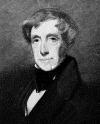Biography
Other info : Furtherreading | Bibliography
Although Clement Clarke Moore wrote only one memorable poem for children, that narrative. "A Visit from St. Nicholas," has assured him of a secure place in the history of American letters. Moore wrote the poem for his own children and recited it to them on Christmas Eve 1822. After it was published anonymously the following year, it became increasingly popular, appearing in newspapers, school readers, other anthologies, and in many different single editions. It is still read today as a traditional part of the Christmas season in the United States and throughout the world.
Clement Clarke Moore was born in New York City, the son of the Reverend Benjamin Moore and Charity Clarke Moore. An only child, Clement was capably tutored at home by his father until he entered Columbia College; according to his biographer. Samuel White Patterson, he graduated in 1798 "at the head of his class, as his father had, thirty years earlier." In 1801 he earned his M.A. degree from Columbia: he was awarded an LL.D. in 1829. A very religious man, he gave a large portion of the land that he had inherited, part of his Chelsea estate and now called Chelsea Square, to the General Theological Seminary, where he was a professor of oriental and Greek literature from 1823 until he retired in 1850. At his retirement he purchased a house in Newport, Rhode Island, where he died on 10 July 1863.
During his lifetime Moore wrote on a variety of subjects. He produced a two-volume A Compendious Lexicon of the Hebrew Language (1809), a translation from the French of A Complete Treatise on Merinos and Other Sheep (1811), and the historical biography George Castriot, Surnamed Scanderbeg, King of Albania (1850). Throughout his life he also wrote poetry, which was published in the Portfolio and similar periodicals. The New-York Book of Poetry (1837), an anthology of works by New York poets, contained some written by Moore, including "A Visit from St. Nicholas," although "Anonymous" was still listed as the author. Not until 1844, when Moore's collection Poems was published, was "A Visit from St. Nicholas" acknowledged in print as having been written by Clement C. Moore, LL.D.
In 1813 Clement Moore married nineteen-year-old Catharine Elizabeth Taylor, with whom he eventually had nine children. There were various versions of how "A Visit from St. Nicholas" came to be written for the six Moore children who were born before Christmas 1822: perhaps the jingling harness of his sleigh that evening gave him his inspiration, or the description of St. Nicholas from Washington Irving's pseudonymous History of New York "by Diedrich Knickerbocker" (1809), or the anonymous poem "The Children's Friend" published the previous year describing "Old Santeclaus" who drives his reindeer "O'er chimney tops, and tracks of snow, To bring his yearly gift to you." Moore totally eliminated moralizing like that found in "The Children's Friend" (no harmful toys are left, such as cannons, swords, or rockets, and toys are left only for "good girls and boys" in the earlier poem), much to the delight of children ever since. Whatever the source of Moore's poem, apparently the physical model for St. Nicholas was a rotund Dutchman who lived nearby.
"A Visit from St. Nicholas" was written in rhyming anapests, a meter ideally suited to the subject. The vivid descriptions, especially of St. Nicholas and his reindeer, remain with the reader long after the poem has been read or heard. Here is sheer delight, for Moore was interested in entertaining his children, not in preaching to them. The eight tiny reindeer have been given names that trip on the tongue, but there is no listing of specific toys such as was included in "The Children's Friend," perhaps because Moore did not want to give his children any hints as to what gifts they would be receiving.
Since Clement Moore had written the narrative poem for his own family, he made no attempt to get it published. There are various reports about how the poem came to appear anonymously the following year in the Troy (N.Y.) Sentinel. Apparently the verses were transcribed by a houseguest who was either Miss Harriet Butler or a friend of hers; in either case, Miss Butler was most likely the person who sent the copy of the poem anonymously to the Sentinel. The editor, Orville L. Holley, published it on 23 December 1823, together with his praise of the poem and "his cordial thanks to whoever had sent him these Christmas verses." The poem was republished numerous times over the years, first in newspapers and other publications, and then in separate illustrated editions, the first of which appeared in 1848 with wood engravings by T. C. Boyd; the publisher was Henry M. Onderdonk of New York. Since that time dozens of editions have appeared; the poem has been translated all over the world and printed in braille and has inspired many illustrators and artists.
Because the poem was published anonymously and became very popular, other people tried to claim authorship. The claimant taken most seriously was Major Henry Livingston, Jr., whose great-grandson spent many years trying to establish Major Livingston as the author. Livingston had also written verses for his children, but he made no written mention of "A Visit from St. Nicholas" during his lifetime, nor had his friends heard of his connection with the verses. They were said to have been published in a Poughkeepsie newspaper long before they appeared in the Troy Sentinel, but no copies of the paper containing the poem have ever turned up. Several magazine and newspaper articles appeared, especially during the 1940s, questioning the authorship, but scholars continue to give the credit to Clement Clarke Moore.
— Marilyn F. Apseloff, Kent State University






